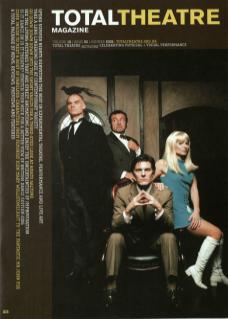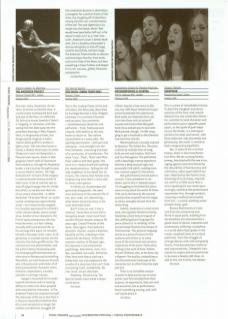One man, many characters. As narrator, he invites us into the show. A curved screen envelops the back wall and part of the floor; it's definitely 2D, but as he moves towards it there's a 'stepping-in' sensation, a bit like seeing Dick Van Dyke jump into the pavement drawings in Mary Poppins. Here, no fairgrounds or foxes, but things equally magical – a metro station where graffiti is written in light; a fairy tale tree that houses a Dryad; a shadow that leaves its owner (Andersen's most terrifying tale); a Parisian town square, drawn in that gorgeous French style of illustration that reached us through the Madeleine books; a train journey through Europe; a rococo theatre interior. The high ‘Romanticism' of much of the imagery is contrasted with fantasy worlds of other sorts. A row of cubicles zips on and off stage (Lepage likes his clunky bits of kit), as we discover that one of our story's characters – a rather Warholian 'I'll be your Mirror' ex-rocker turned contemporary opera libretto writer – has inadvertently swapped his Canadian apartment for a friend's rather sleazier abode, above a peep-show. Another of our characters, the French opera entrepreneur who has hired the writer, is a fast-talking smoothy with a sad private life; as his marriage falls apart, he consoles himself in the peep-show. Later, an Algerian boy in a hoodie sloshes out the cubicles: the metro graffiti writer. The cubicles turn into phone booths, and the writer's phone relationship with his estranged girlfriend becomes another play on fantasy and storytelling. Meanwhile, we meet Andersen himself, who is the precursor and holder of all these personalities: Romantic writer, fantasist, masturbator, traveller, Outsider in a foreign country.
Lepage is renowned for his multi-layered narratives and his amazing ability to create solo shows peopled with many distinct characters. In The Andersen Project he surpasses himself. The character shifts are so fast that it is close to impossible to believe that this is just one person on stage; the clothes and identities shrugged off like snakeskins become in themselves a metaphor for a central theme of the show: the sloughing off of identities, moving into the new, transformation of the self. The only slight blip is his morph into the Dryad, which I feel would have been better left out: s/he doesn't really cut it as a 'real' character. Andersen's lover is better dealt with: she's a headless dressmaker's dummy who glides on and off stage, another beautifully realised image. The Andersen Project builds on devices and techniques familiar from works such as Far Side of the Moon, but here everything is taken further and deeper. It's a rich, luscious, gilded, Romantic masterpiece.

